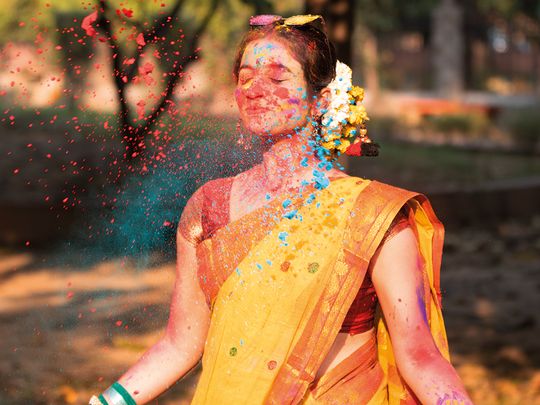
Holi, the Indian festival of colours, enjoys massive popularity across communities globally, including in the UAE, home to one of the largest Indian diasporas in the world. Much of the time during Holi is spent in festivity, with the pomp and gaiety associated with the celebration. However, in recent years, there has been a marked increase in awareness about the types of colours being used. As more UAE residents become alert to the health risks associated with chemical colours, which can cause skin irritations, allergic reactions, and even long-term health issues, the use of organic colours and a holistic approach to celebrating Holi are becoming more popular. Dubai-based entrepreneur
Amit Vardhan believes the trend toward organic colors has come full circle, as he remembers playing Holi with natural wet and dry colours as a child.
Age-old trend
“We used to get a sackful of tesu ke phool — the blossoms of the Palash flower tree — to make colours to celebrate Holi,” says Vardhan, speaking to GN Focus. “These flowers were boiled in big drums at home and used for wet colours. Dry colours were generally the gulals.
“Holi celebrates nature, welcoming Spring with a riot of colourful flowers. Generally, the flowers are delicately plucked from the trees where they sprout two or three days before Holi. The petals are then carefully removed from the stem and dried in the sun. When they are dry, they are crushed by hand to make a natural, rich paste of colour that can be additionally dried to make a powder or used as a wet colour.”
Vardhan adds that the common hues obtained from these and other splendid flowers offer several benefits to the skin and are not poisonous to the environment. “However, due to the lesser accessibility of these blossoming trees in urban cities and the lower manufacturing expenses of industrial colours, tesu has lost its value for Holi,” he feels.
“Colours gradually became made with synthetic ingredients, including toxic substances like acid, glass powder, industrial dye, lead oxide, mercury sulfite, copper sulfate, and lead oxide, which can cause skin itching, rashes, eye irritation, hair damage, and gross harm to the environment.”
Now, with people becoming more conscious about celebrating Holi the way it used to be enjoyed back in the day, the trend of choosing better and safer colours is returning.
Source from the best
Long-time Dubai resident Darshita Thakur’s Holi celebrations begin with sourcing organic colours from reputable vendors specialising in natural pigments derived from plants and herbs. “These colours offer a stunning array of hues and peace of mind, knowing they are free from harmful chemicals,” says Thakur, an event management consultant. “We’ve also started making our own colours using turmeric, beetroot, and spinach. It is a fun and creative activity that allows us to customise the colours to our liking while avoiding synthetic dyes altogether,”
She adds that celebrating Holi with fewer chemicals has been a rewarding experience for us. “We enjoy the vibrant colours and festive atmosphere and feel good knowing we’re moving towards a more sustainable future.”
“Clients increasingly seek organic colours as alternatives to traditional synthetic colours,” says Dr Dhananjay Datar, Chairman and MD of Adil Group of Super Markets, accepting a cultural shift in consumers towards embracing sustainable practices.
“People are choosing organic colours to enjoy the festival without compromising their health or the environment. Our customers appreciate the vibrant hues and the peace of mind that comes with knowing they’re celebrating responsibly. It’s a joy to be part of this movement towards a more sustainable and mindful Holi celebration.

People are choosing organic colours to enjoy the festival without compromising their health or the environment. Our customers appreciate the vibrant hues and the peace of mind that comes with knowing they’re celebrating responsibly
“Organic colours are pigments derived from natural sources such as flowers, vegetables, and spices. They are free from harmful chemicals like lead, mercury, and other toxins commonly found in synthetic dyes. They are also biodegradable and safe, making them environmentally friendly.”
Palash Rijwani, Retail Operations Head, Madhoor Stores, says, “Our herbal range of organic colours is chemical-free and safe to use, made from natural ingredients like cornstarch and natural food-grade dyes. Even our normal colours (non-organic) are non-toxic and can be washed away.
“Our customers are selective about what colours they buy and want to use products that are not harmful to the skin. Kids get fascinated by pichkaris (water piston) which come in different shapes and sizes.
"Holi is celebrated on a large scale in the UAE, and many events are organised where people go and play Holi.”






